With the clubs in the Indian Super League trying to hunt down new managers for their side, the Goans have already secured the signing of Manuel Marquez Roca, AKA Manolo Marquez, the head coach of Hyderabad FC. Every Indian football fan knows how he transformed Hyderabad into one of the strongest teams in the league. Now, he’s being trusted with the job to help Goa get back on their feet after a poor run of seasons.
In this tactical analysis, we’ll be analysing the head coach of Goa FC for the upcoming season, and we’ll perform an analysis of his tactics and try to understand the impact he’ll be aiming to create. We’ll also use Hyderabad as a reference and will keep comparing it to Goa in each and every section of this piece.
Team Overview
Ever since Juan Fernando left Goa FC, the team’s been declining. Although they do show promising traits, they tend to miss out on the playoff spots. From making it to the semis four seasons in a row, they’ve now failed to make it to the top four for two consecutive seasons. First, let’s begin with analysing the team and what’s causing them trouble.
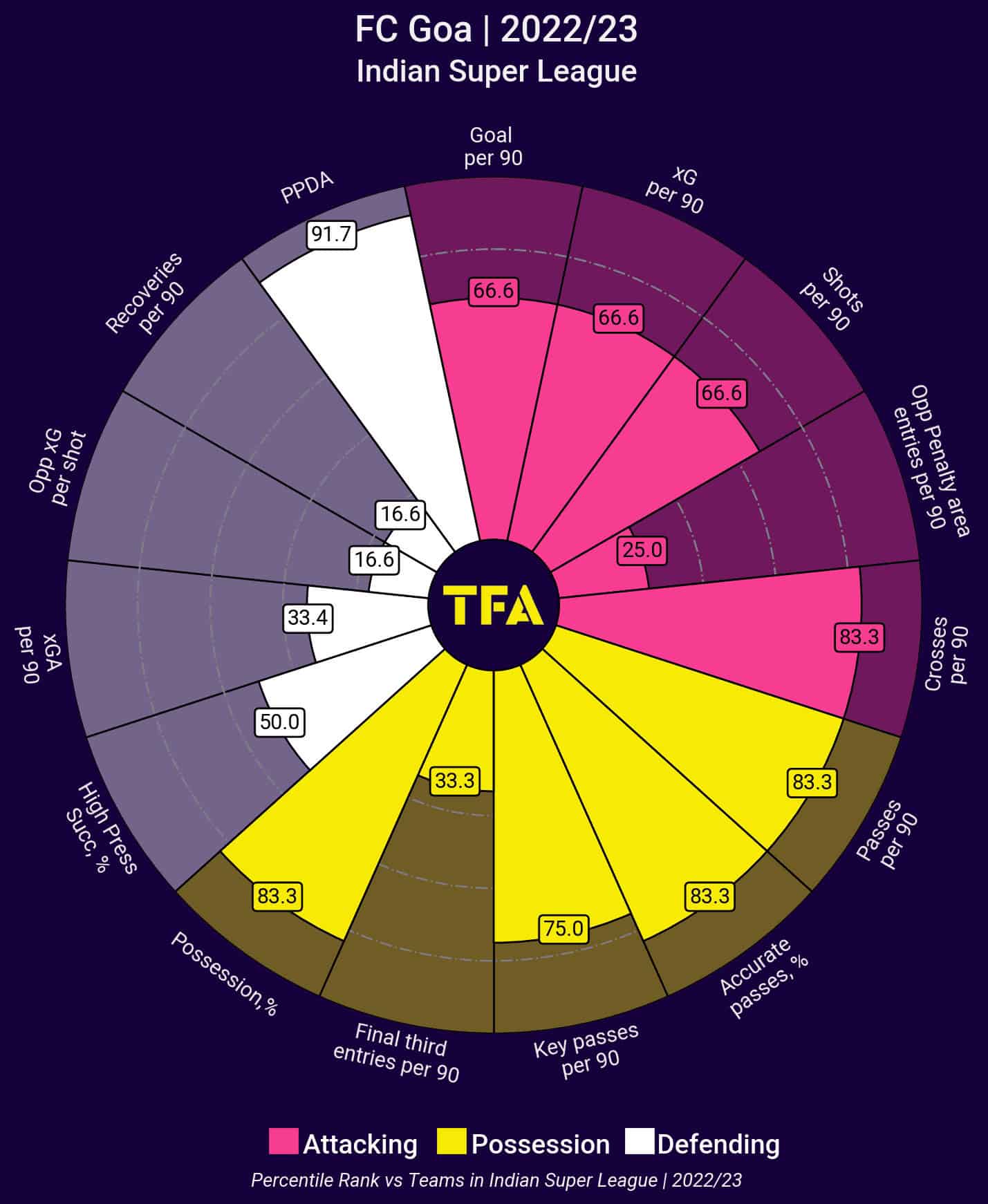
On looking at how Goa have performed this past season through the eyes of data, one can easily state that they’ve been really good in terms of attacking in maintaining possession. But some obvious areas they struggled are entries to opponents’ penalty area and final third entries. With so much possession in hand, it’s quite obvious they struggled to capitalise on the possession they enjoyed this season.
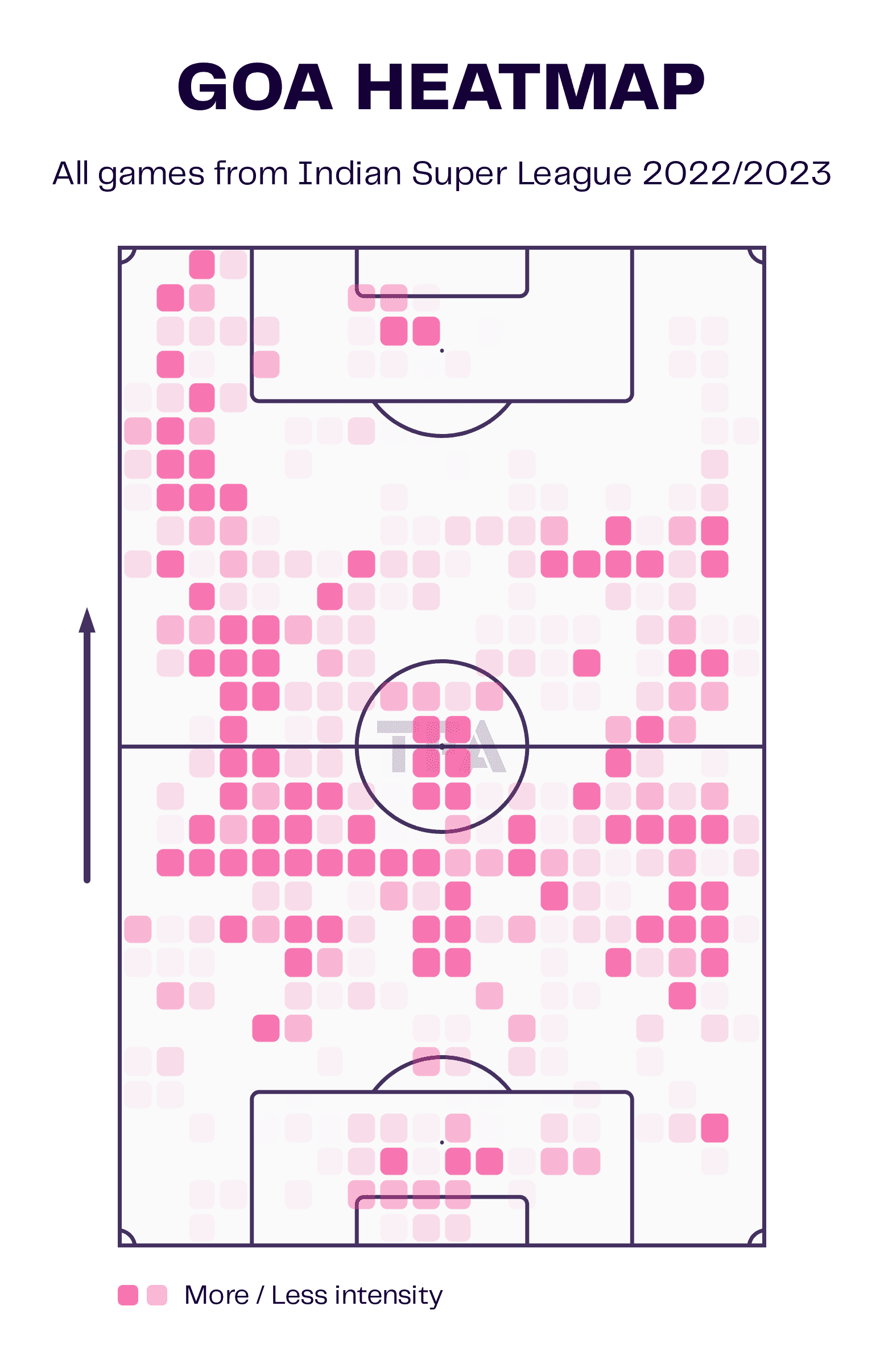
By looking at their heatmap from this season, we can see how there are very few entries in the final third. Although there’s progression through the left, the majority of possession can be seen in the own half which validates our earlier statement of Goa struggling to capitalise on the possession they enjoy in every game.
Another area of concern would be defending. They scored 36 goals this season, the joint-second highest with Hyderabad, but what let them down in their defending as they’ve conceded 35 goals. In this next section, we’ll try to find out why Goa went with Manolo as their head coach for the next season.
Why Manolo Marquez?
As I mentioned earlier, we all are aware of how Manolo transformed Hyderabad into a competitive team and how impressive their progress was. In his first season at the club, he changed Hyderabad drastically and made everyone fall in love with the way they play despite missing out on qualification and ending up in fifth place.
One reason why fans fell in love with this coach and his style of play is the team’s approach in possession when compared to their previous season without Manolo. The only thing they lacked was finishing which was addressed in the following campaign (2021/22) when they signed Bart Ogbeche who ended up converting the chances and then ultimately won the title. Goa are in a similar situation, but from a different angle.
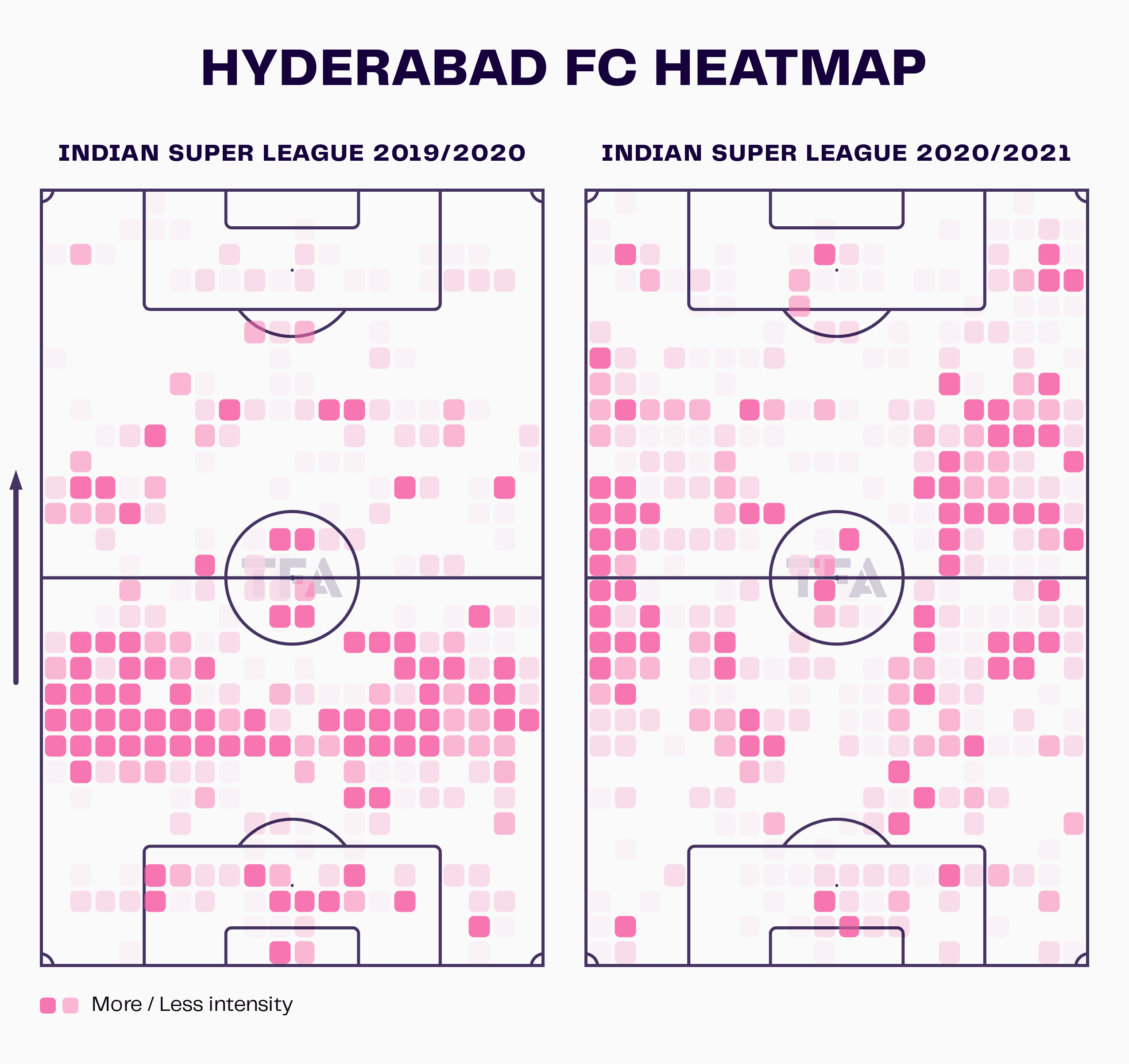
The above is a heat map of Hyderabad before Manolo arrived and after he arrived. The one thing we can see in common in Goa’s current season and Hyderabad’s 2019/20 season is how both the teams are very active in their own half but in the very next campaign for Hyderabad, we can see how enormously the team has transformed and we can see a lot of play in the opponent’s half. This is what is expected from Goa in the new campaign — a similar influence on the team’s progression.
As such, we know Goa are good in terms of attacking and converting chances and with the amount of possession they enjoy if they could get the ball progression right under Manolo, the team can be unstoppable. They could focus on defence too, but the management realises the major concern is in the team’s way of progression which, if addressed, could solve all the problems for Goa.
Adaptability-wise too, it shouldn’t be a huge problem as Manolo too prefers playing in a 4-2-3-1 as do Goa, so the style of play would remain similar if not the same, but what we could expect is a change in the tactics. In the upcoming sessions, we’ll be analysing Manolo’s off-the-ball and mostly in-possession tactics.
Off-possession
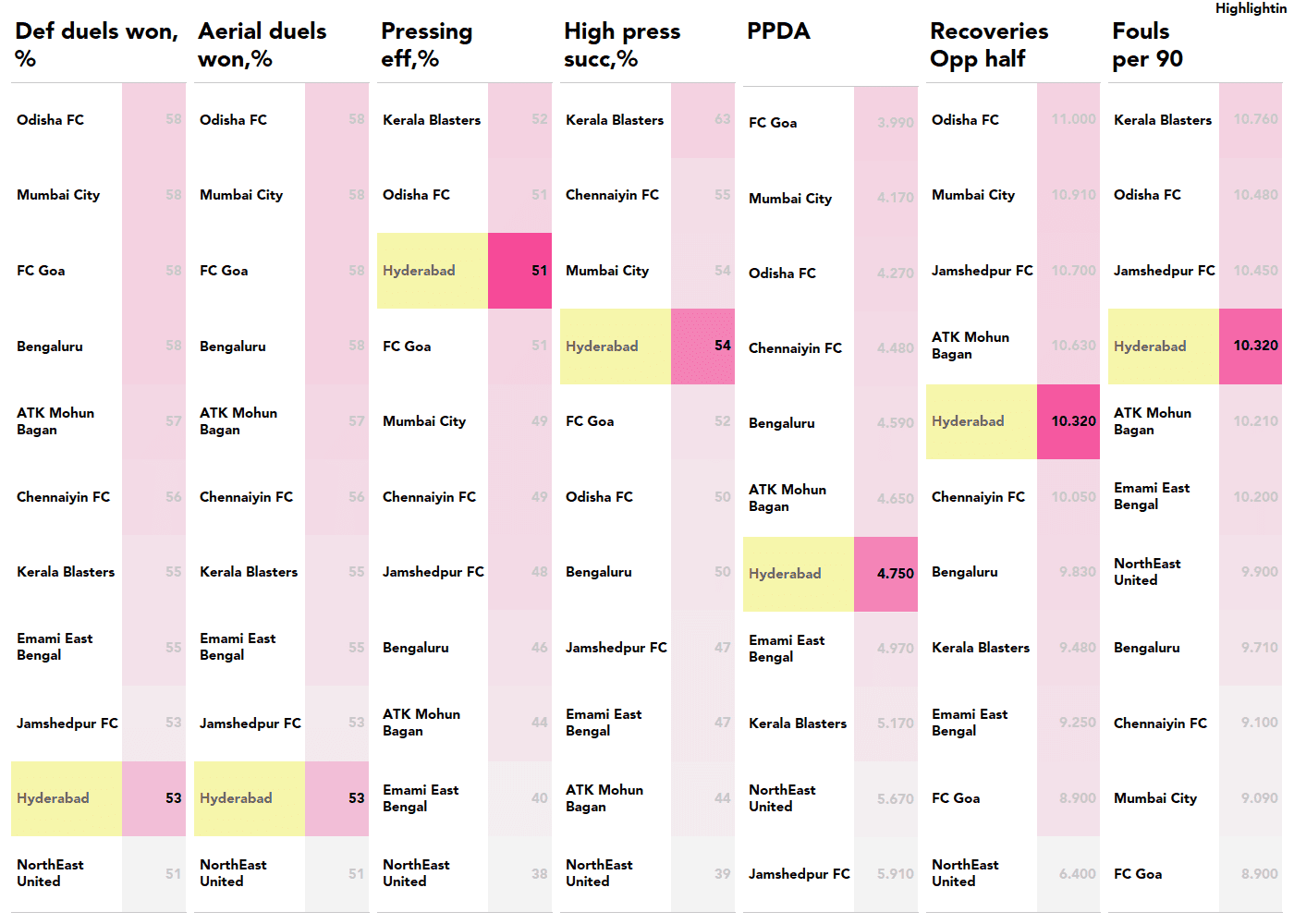
Before we jump right into off-possession play, it’s good to analyse the numbers of Hyderabad from this season. While their defensive win rate is low, which could be influenced by so many factors, let’s look at their ball-winning abilities. Their pressing efficiency and recoveries in the opposition half are all very good and a little better than Goa.
Let’s now analyse the defensive tactics of Manolo. Once in the final third, upon losing possession he prefers the immediate man near to close down the ball possessor.
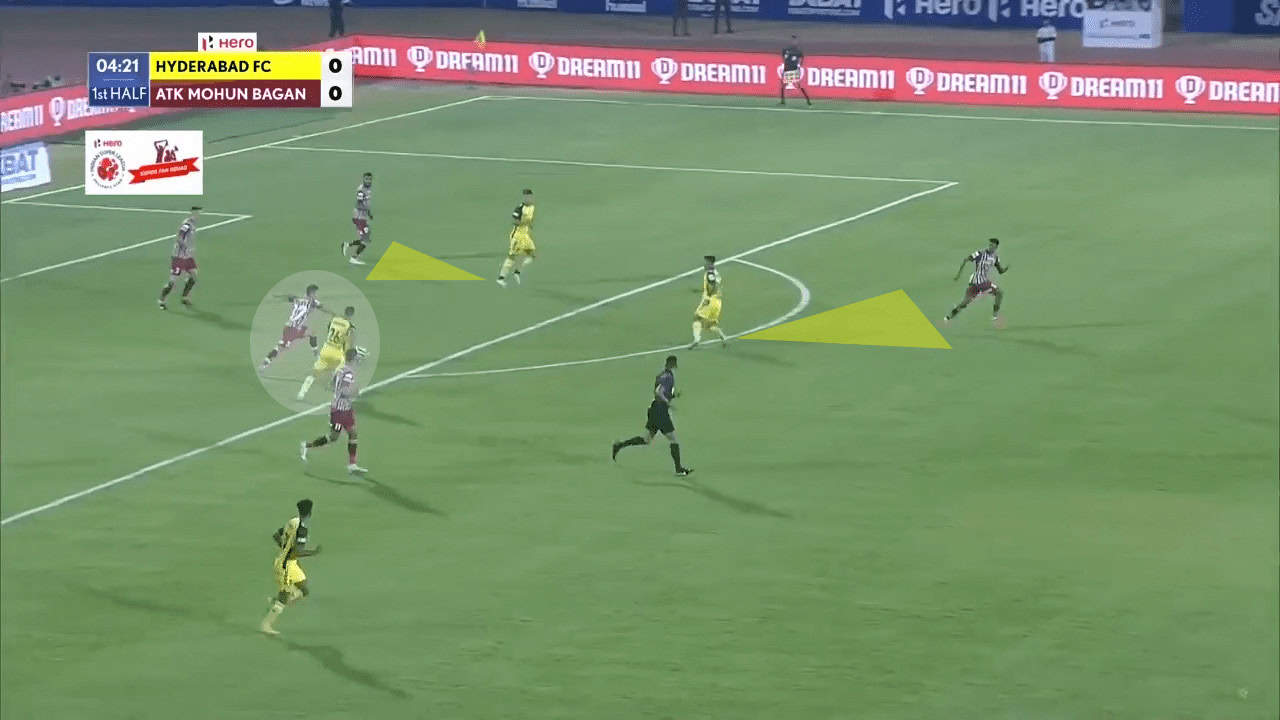
From this match image, we can see upon losing possession, the one closest to the ball is applying pressure on the ball possessor, while the players around are indirectly influencing this play. They have closed off the possible passing lanes, adding more pressure on the ball possessor. As a result, Hyderabad look to force the opponents to play long and then win the aerial duels to regain control of the ball.
While the opponent’s building from the back, their 4-2-3-1 quickly switches to a 4-4-2 formation.
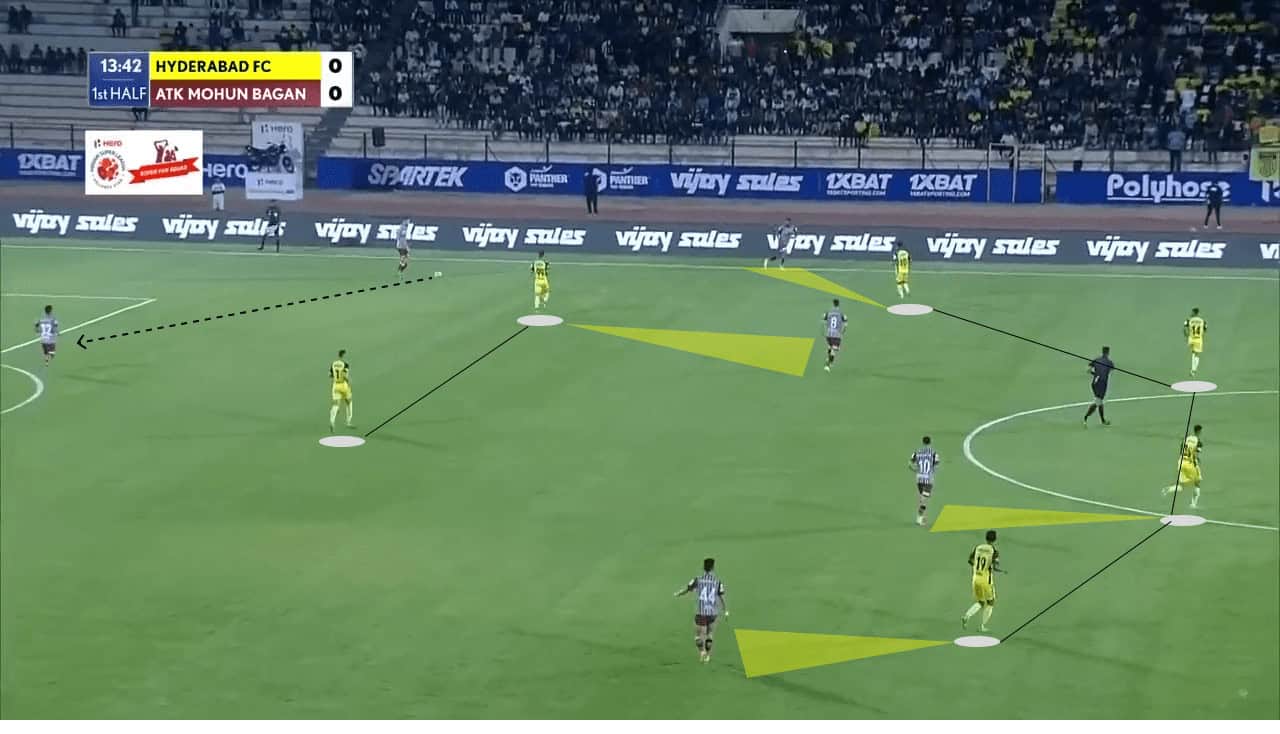
The reason to adjust to a 4-4-2 is to cover as much ground as possible and keep the centre very compact. You can see how every place is shadowing an opponent making it hard for the opponents to progress. They form a triangle on the flank to defend making it impossible to progress through the flank or the centre. This forces them to play back until they see an opening, which is very hard, hence many teams decide to go long which Hyderabad see as a victory. They can then compete for the ball in the air and win their duels.
While deep in the defending third, the team constantly switches between a 4-1-4-1 and a 4-4-2 — depending on the opponents and the match situation. Again the idea in their own third is to stay extremely compact and force them to play through the flanks.
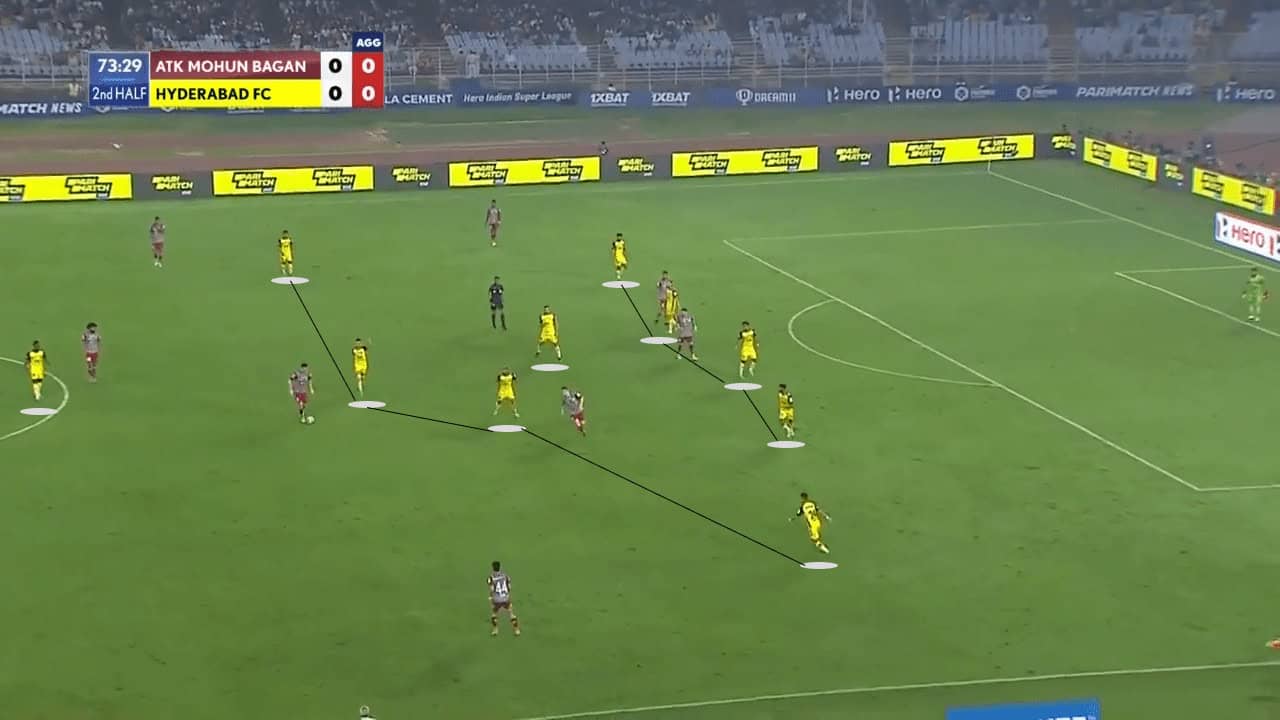
You can see the team in a 4-1-4-1 formation here — the four midfielders try to keep the centre compact while the solo defensive midfielder looks for spaces to close down to prevent the through passes which could threaten them. You can also notice how compact the back four are pretty much allowing the opponents to go through the flank which is of less danger.
The idea behind the team’s defensive tactic is very simple and well-executed. When in the attacking third, they put pressure in more than one way forcing the opponent to go long which then they’ll be able to win. When in the defending third, they stay compact, almost making it impossible for opponents to go through the middle.
Goa having a higher defensive success percentage may be a sign that they can only elevate this tactic of his and prove to give better and more effective results. The fans can pretty much expect a very disciplined defensive performance from Goa next season.
In-possession
When it comes to attack, the coach is full of ideas and is unpredictable. He also makes his team flexible to attack in many ways based on the match situation. When building up from the back, the formation looks like a 2-3-1-3-1. With two centre-backs trying to build the play and one of the defensive midfielders dropping in line with the full-backs.
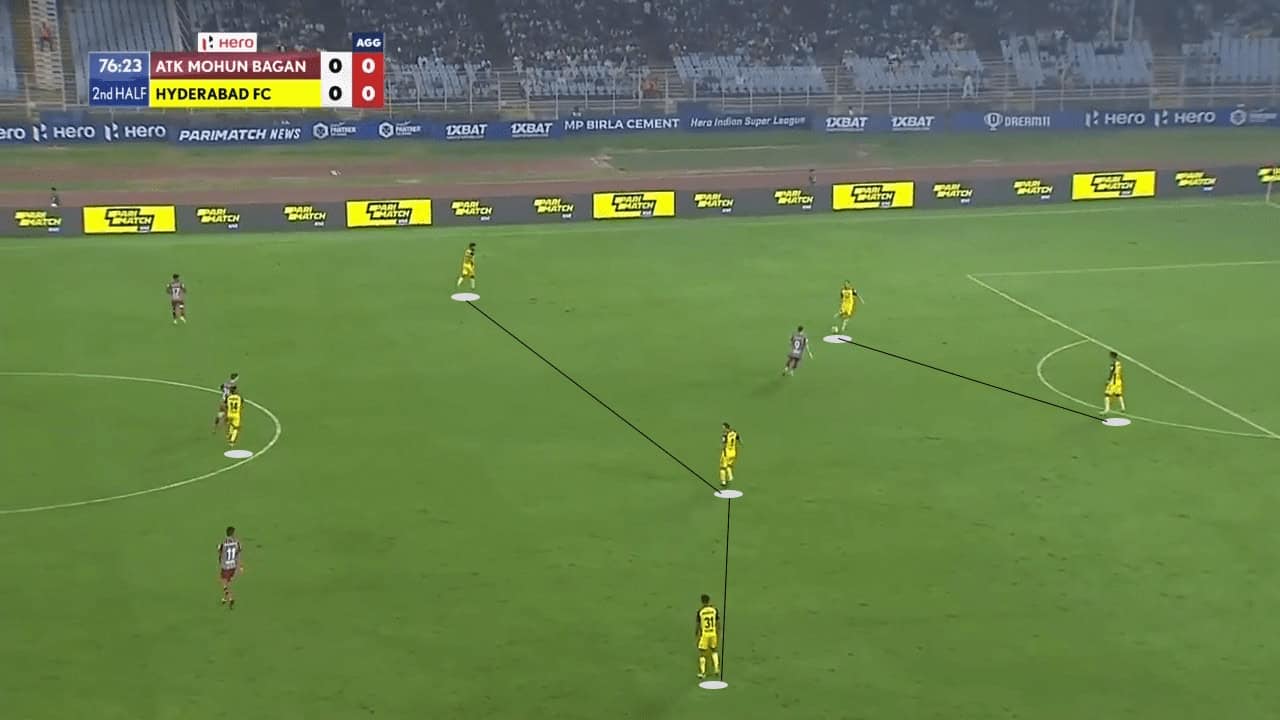
So the other defensive midfielders try to balance this formation and drop back to support when required, while the attacking three stay compact in the middle, forcing their defence to stay compact. As a result, the full-backs have complete access to penetrate through the flanks from the build-up.
The full-backs play a crucial role in this system as they’ll be mainly responsible for progression. By committing full-backs to the attacking third along with the attacking midfielders, the coach tries to create numerical superiority.
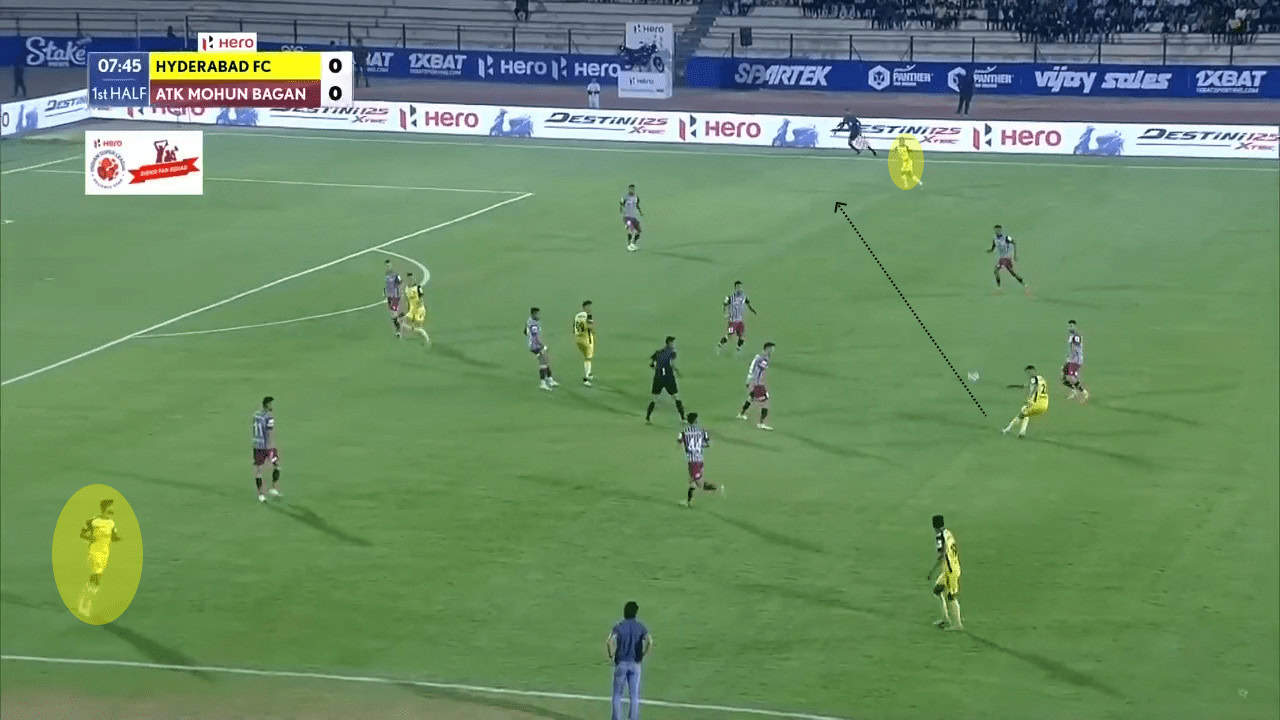
From this match image, we can see how high Aakash Mishra, the left-back, is positioned on the left. By pinning down players to one side of the pitch, the right full-back sticks to the line being able to enjoy the space created by overloading on this side of the flank. The opponents have no choice but to stay compact in terms of overloading to avoid through passes falling exactly into the trap of the coach.
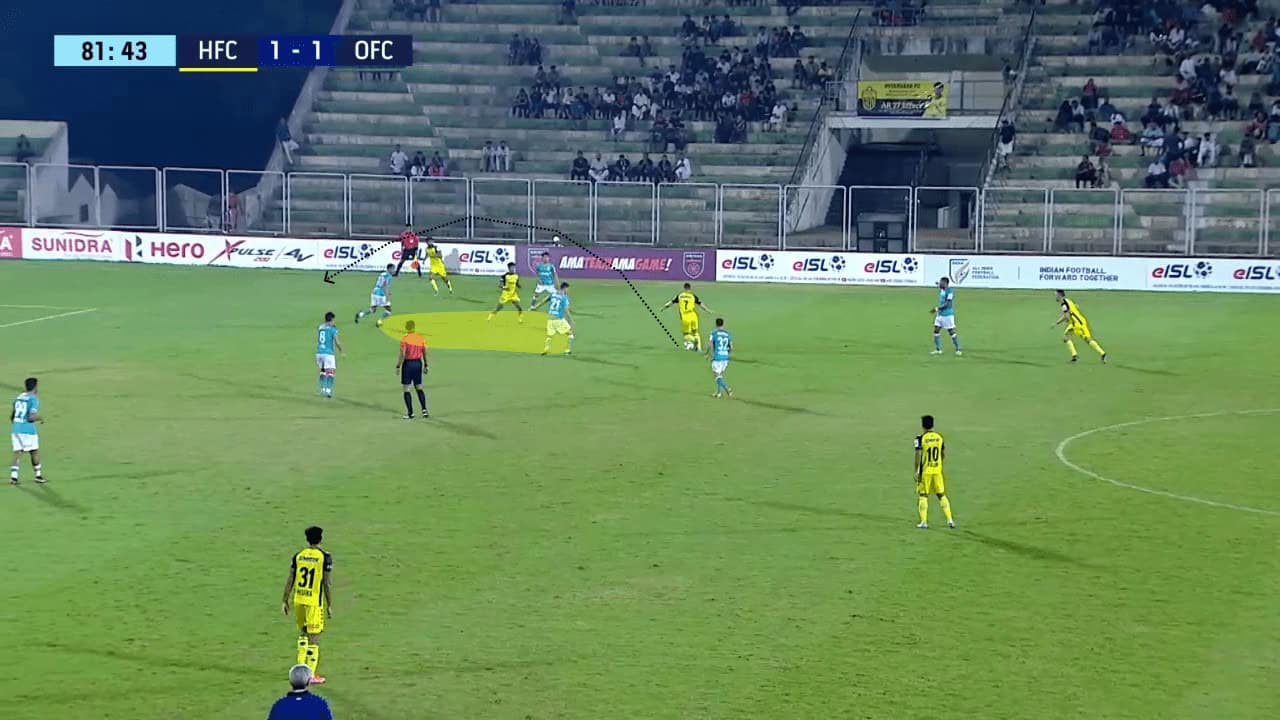
The match image is another good example of the use of full-back. While the attacking midfielder is pinning down three defenders to him gaining all the attention, the full-back makes a smart run into the space behind the defence.
Another using of a full-back is to use the attacking midfielder as a decoy.
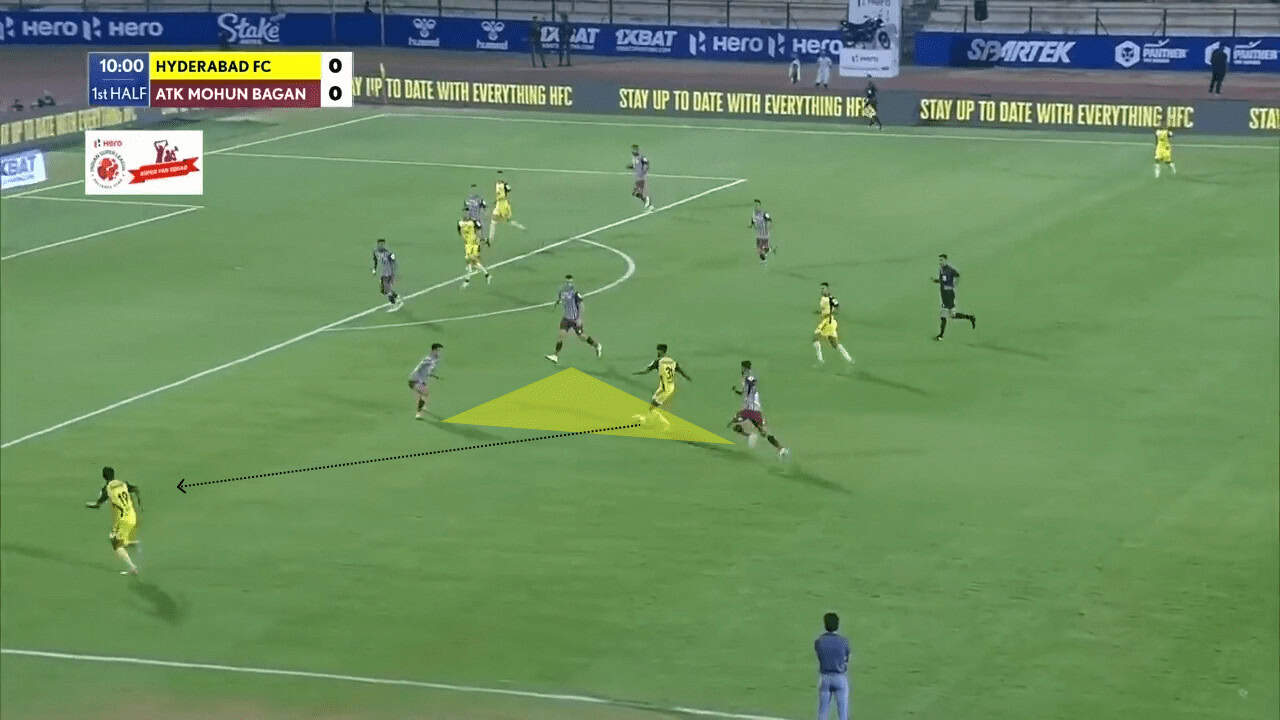
In the above match image, we can see how by dribbling towards the goal, the player acts as a centre of gravity for the defenders but he isn’t the actual threat. He acts as a decoy and tries to create space for the player on the flank.
So the full-backs are the actual stars under Manolo’s way of progression, which is complemented by the attacking midfielders mainly, as well as the other players. Even to penetrate via the middle, the full-backs are required to make dummy runs out on the flanks trying to open up the opposition’s defence.
Conclusion
With Manolo as the head coach, Goa fans can be more than confident of the team breaking their pattern of bad form over the last two seasons. Not to forget Manolo also puts a strong focus on set pieces, which could give Goa a new goalscoring dimension. Whether his tactics will work again and help Goa get back in form is something only time can answer, but something that we can be sure of is that Goa will be pretty exciting to watch in the upcoming season!

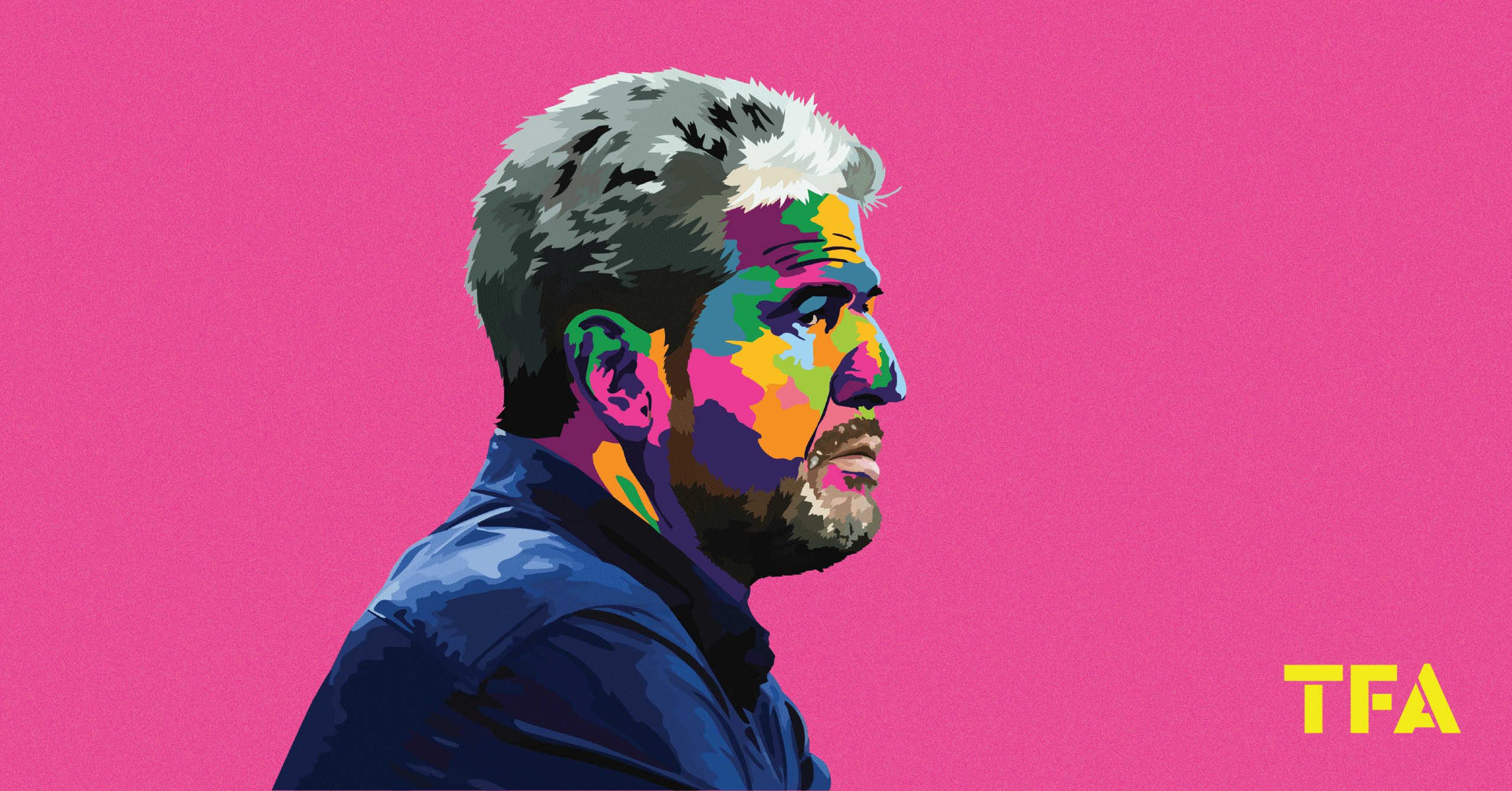



Comments